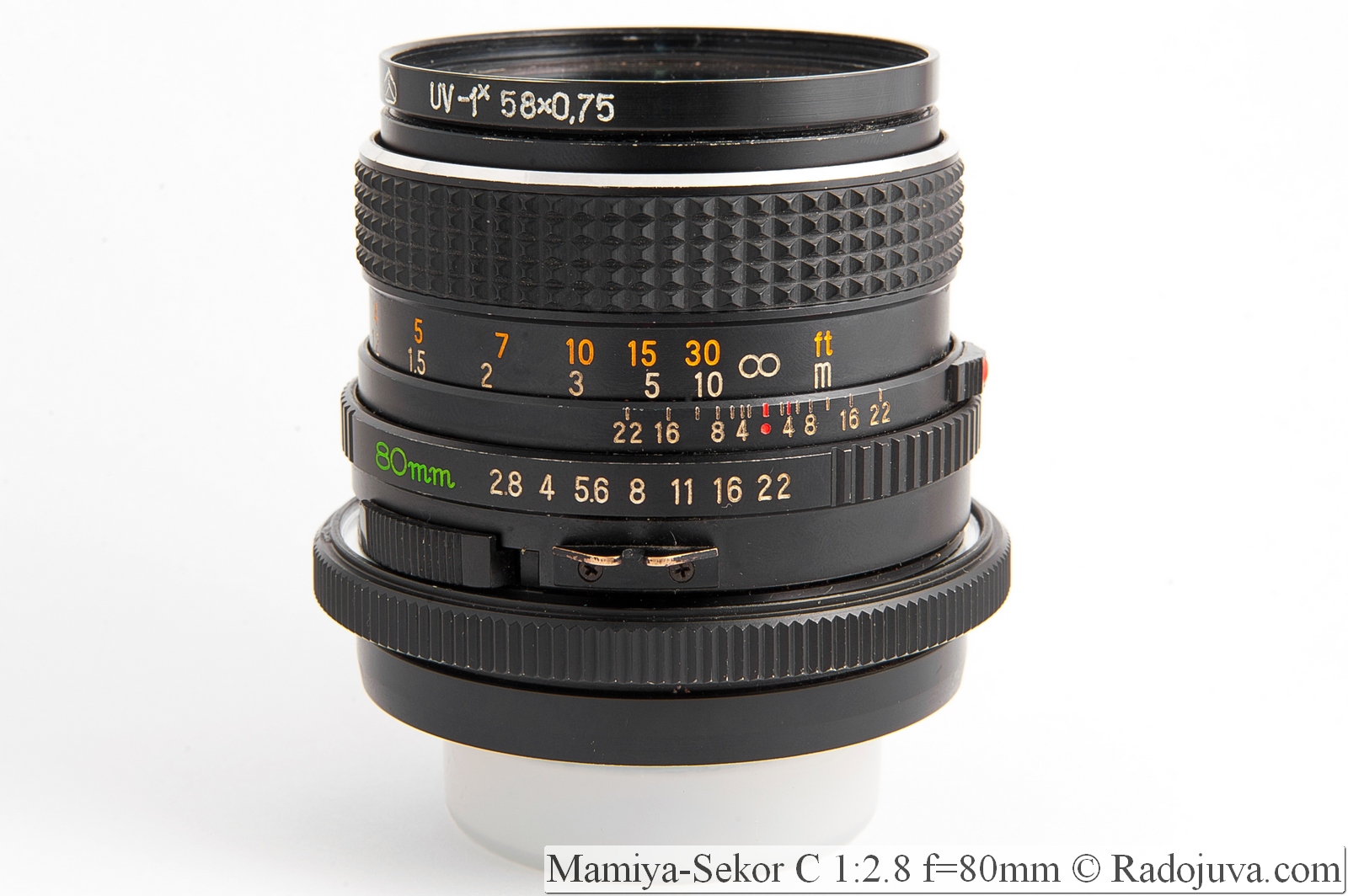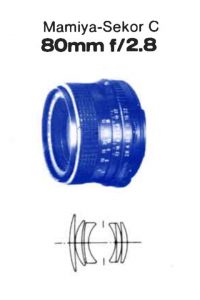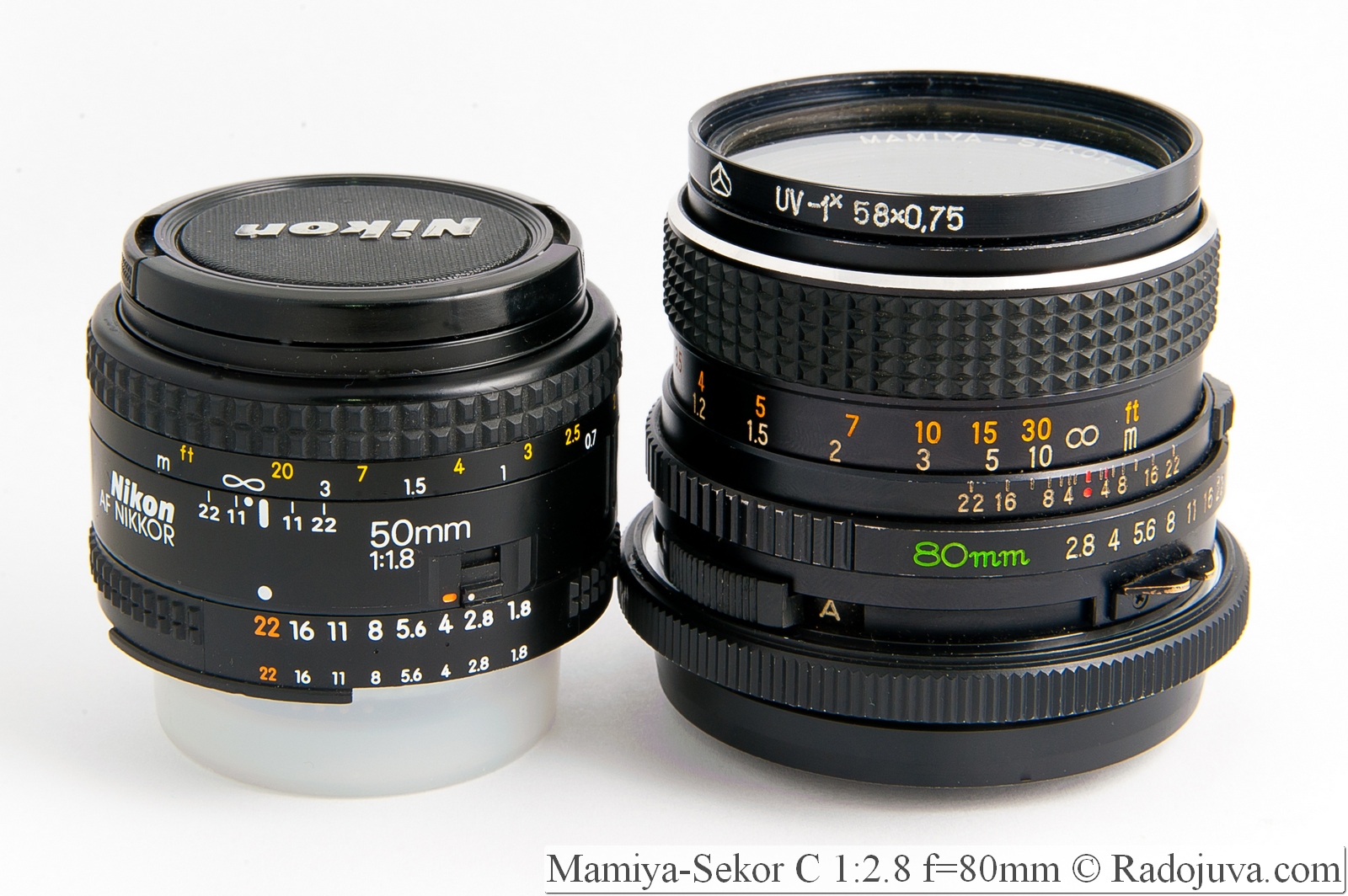According provided by lens Mamiya-Sekor C 1: 2.8 f = 80mm many thanks to Tsabak Nikolay.
The lens came to the review in an adapted form for Nikon F mount, with a jammed Arsenal UV-1x 58 × 0.75 filter. The filter thread is bent. It is difficult to determine the source of the resulting backlight glare (either from the filter, or from the lens).
Mamiya-Sekor C 1: 2.8 f = 80mm is a standard lens for medium format cameras of the Mamiya 645 series with a frame size of 6 cm X 4.5 cm (frame diagonal 75 mm, crop factor Kf = 0.58). On narrow-format cameras, of course, it will not show all its charm, but, nevertheless, is suitable for use.
To be brief, the Mamiya-Sekor C 1: 2.8 f = 80mm in medium format corresponds to fifty dollars in full frame. We can say that for medium format cameras of the Mamiya 645 series this lens is the simplest.
Main technical characteristics of Mamiya-Sekor C 1: 2.8 f = 80mm:
| Review Instance Name | Mamiya-sekor C 1: 2.8 f = 80mm No. 91411 |
| Basic properties |
|
| Front Filter Diameter | 58 mm, metal thread for filters. |
| Focal length | 80 mm |
| Zoom ratio | 1 x (this is a fixed lens) |
| Designed by | for medium format cameras with a frame size of 6 X 4.5 |
| Number of aperture blades | 6 rounded petals. Petals form a regular hexagonal hole. |
| Tags | bayonet mount red mark, focus distance scale in meters and feet. The depth of field scale for F / 2.8, 4, 5.6, 8, 11, 16, 22. Label for working in the infrared spectrum. |
| Diaphragm | from f / 2.8 to f / 22. The lens has an aperture control ring. The ring has marks for F / 2.8, 4, 5.6, 8, 11, 22 and 'lugs'. There is an aperture mode switch (automatic aperture control works only on cameras of the Mamiya 645 series). |
| MDF | 0.7 m |
| The weight | November 250, XNUMX |
| Optical design | 6 elements in 5 groups. 'Planar' type scheme.
Data taken hence. |
| Lens hood | no marking screwed into front filter |
| Manufacturer country | LENS MADE IN JAPAN (lens made in Japan). |
| Period | From 1975 to 1987 (approximately). Subsequently replaced by Mamiya-Sekor C 80mm 1: 2.8 N. |
The lens has been assembled for centuries and will last a very long time (classic of the 80s). The focus ring is rubberized and rotates 180 degrees. The focus ring travel, on the copy from the review, is tight. During focusing, the frame rim lengthens, but the front lens does not rotate.
Image quality and sample photos
In order to drive well and understand the lens, it should be used on a medium format camera with a digital back. On narrow-format cameras, the edges of the frame are cut off and it becomes difficult to qualitatively judge the lens. Nevertheless, the Mamiya-Sskor 80 / 2.8 is a good lens with moderate sharpness, a mediocre contrast.
Of the features - the lens pretty cool (greens) the pictures, which ultimately leads to the 'bottle color'. The bokeh is rough.
On a narrow format, the Mamiya-Sskor 80 / 2.8 can be used as a creative lens, including for portrait shooting.
Download RAW c source photos Nikon D700 can by this link. With this lens, I visited nice wedding in the botanical garden.
Download jpeg source photos from Nikon D70 can by this link.
Comments on this post do not require registration. Anyone can leave a comment. Many different photographic equipment can be found on AliExpress.
Reviews of other Mamiya lenses can be found here.
Thank you for attention. Arkady Shapoval.













































Thanks for the review, I liked the lens ... built to last ...? Happy Holidays to all Orthodox Christians ...
Just a little planar. 6 lenses, 6 aperture blades - classic
All ugly comments have been permanently deleted. Peace, labor culture.
not bad!
If the crop factor is 0.58, then on a full frame 80 will turn into 138. Something like this.
Yes, no, on cameras with a sensor size of 36 * 24 mm it is 80 mm. Nothing turns. Even on medium format it is 80 mm and even on crop it is 80 mm. The crop factor is convenient for recalculating EGF.
EGF in the medium format will be about 47 mm (0,58x), in the full frame (1x) it will be 80 mm, in the crop (1.5X) it will be 120 mm.
In the article it is written “In short, the Mamiya-Sekor C 1: 2.8 f = 80mm in medium format corresponds to fifty dollars in a full frame.”
So what? According to the viewing angle along the diagonal of the frame in medium format, it is equal to fifty dollars (47 mm) in full frame.
I’m already tired of these misunderstandings with crop factors, in each review there are people who are trying to invent a bicycle or do not understand the essence of the issue :).
I like this. More sharp and contrast than Vega-12B, and the same "air".
On a full frame in general lyapota :)
It looks like my Vega 12 B. The sharpness is the same and without the sun the cotrasta is almost not enough.
The glass is clearly sharper than Vega-12 and, possibly, Wave-3. But is it more interesting? Hard to say.
Welcome all! Has anyone watched this site? http://www.photonstophotos.net/ It shows the dependence of DD on ISO, a very convenient interface, but how much can you trust it ?, the values differ, say the same http://www.dxomark.com/
I use the N (new, more recent) version of this lens (and its other relatives). I have samples on FF (and after a while and CF). The samples from this review ... somehow discredit the subject. (he had a 150mm 3.5 old one (it is, however, f / 4) and N f / 3.5, I didn't notice the difference, but it is in favor of N)
I have such a lens, although it is slightly different from yours - a focus ring.

almost all medium format lenses have a very high microcontrast (an unfortunate English word - in photography it does not mean contrast in details (and has nothing to do with the concept of microcontrast in graphics programs!), but the lens's ability to transmit more shades of gray, or shades between similar colors, this is especially important for black and white photography). This one is also no exception, the pictures are very lively and voluminous. Personally, I have used three Mamiya lenses for medium format (6x4,5) for a very long time in the film era and I regret selling them ...
Wonderful glass! I don't understand why the author didn't like it? ..
Sharpness is enough, bokeh is soft. On Wave 3, the sharpness can be even greater, but the picture there is once again harder.
Something's wrong with your lens probably, because the resolution figures of the Mamiya 80/2.8 are excellent.
Here are links to two sources:
https://ianbfoto.com/downloads/Mamiya%20645/Mamiya%20645%20Lens%20Tests%20-%20Popular%20Photography.pdf